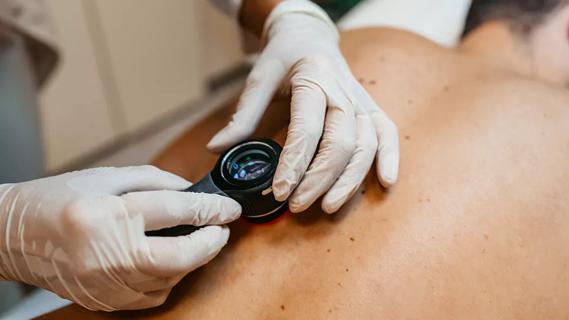The who, what, why and how of skin checks

You visit your primary care doctor every year for a checkup, and schedule regular teeth cleanings with your dentist — but what about your dermatologist?
Advertisement
Cleveland Clinic is a non-profit academic medical center. Advertising on our site helps support our mission. We do not endorse non-Cleveland Clinic products or services. Policy
Dermatologists are specially trained in detecting skin cancer, the most common form of cancer in the U.S. Most skin cancers are highly treatable, especially when they’re caught early, so having skin cancer screenings is an important part of your healthcare routine.
Any adult who’s never had one should consider scheduling a full-body skin exam to establish a baseline and to discuss whether, or how often, regular skin checks are necessary, says dermatologist Kathryn Riley, MD.
Annual skin exams may be recommended for anyone who:
Your appointment will involve a thorough examination of your skin — from the top of your scalp to the bottoms of your feet — by a dermatologist. They will look for suspicious spots that could be cancerous.
There are three main types of skin cancer: basal cell carcinoma, squamous cell carcinoma and melanoma. While they each look different, the most common warning sign of any kind of skin cancer is a change on the skin, such as a new growth or a visible change in an existing growth or mole.
Advertisement
Ahead of the appointment, make note of any spots on your skin that you’re concerned about, and be sure to bring them up before your doctor gets started.
For the exam, you’ll be asked to remove all of your clothing and put on a gown.
“The provider often has a particular pattern with which they systematically look at all of the skin,” Dr. Riley explains. “They may use a bright light or hand-held magnification tool called a dermatoscope to look at skin lesions in more detail.”
To make this as easy as possible, she recommends that you do the following before your appointment:
If your doctor doesn’t find anything suspicious, the exam shouldn’t take more than 15 minutes.
If your doctor finds a spot that could be cancerous or pre-cancerous, they’ll likely want to take a picture for your medical chart and perform a skin biopsy.
During a biopsy, the doctor will remove a small amount of tissue to be examined under a microscope by a pathologist. This is a simple procedure that can be done right then and there, in the office. They’ll clean the area of skin where the spot is located, numb it with an injection of anesthesia, and use a blade or scalpel to take a sample of the skin. You shouldn’t feel any pain, aside from the pinch from the injection.
That sample will be sent to the lab for testing, and your doctor will share the results with you when they are available. This usually happens within a few days but could take up to a week or longer.
If the spot turns out to be cancerous, it may need to be completely removed or treated with other methods, Dr. Riley says.
Regardless of how often you see your dermatologist, you should do your best to monitor your own skin – and that of your partner or close family members.
Grab a mirror and perform a skin exam of your own every three to six months, Dr. Riley suggests.
Look for moles or spots that:
And, above all else, practice safe sun habits to prevent skin cancer from developing in the first place.
Advertisement
Learn more about our editorial process.
Advertisement

Why you need them and which ones you need

The size, shape and color of moles may offer clues that point to melanoma

Colonoscopies and sigmoidoscopies are types of endoscopies, procedures that look at the health of your large intestine

A steady increase in cases in those younger than 50 started decades ago

If you’re at average risk, it’s recommended that you get your first colonoscopy at age 45

Anything from minor irritations and chronic diseases to, yes, cancer can cause persistent itching

Family history matters for melanoma, but the connection isn’t as strong for other skin cancers

Your risk goes down once you quit, but you may still need a lung cancer screening

Type 2 diabetes isn’t inevitable with these dietary changes

Applying a hot or cold compress can help with pain